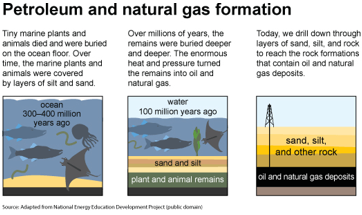What is Natural Gas?
 Natural gas is the earth's cleanest fossil fuel and is colorless and odorless in its natural state. It is composed of four hydrocarbon atoms and one carbon atom (CH4 or methane). Once natural gas has been generated by nature, it tends to migrate within the sediments and rocks in which it was created, using the pore space, fractures, and fissures that occur naturally in the subsurface. Some natural gas actually makes it to the surface and shows up in seeps, while other gas molecules travel until they are trapped or impeded by impermeable layers of rock, shale, salt, or clay. These trapped deposits are the reservoirs where we find natural gas today.
Natural gas is the earth's cleanest fossil fuel and is colorless and odorless in its natural state. It is composed of four hydrocarbon atoms and one carbon atom (CH4 or methane). Once natural gas has been generated by nature, it tends to migrate within the sediments and rocks in which it was created, using the pore space, fractures, and fissures that occur naturally in the subsurface. Some natural gas actually makes it to the surface and shows up in seeps, while other gas molecules travel until they are trapped or impeded by impermeable layers of rock, shale, salt, or clay. These trapped deposits are the reservoirs where we find natural gas today.
Indiana's Natural Gas Landscape
In Indiana, the IURC regulates the rates, charges, and terms of service for intrastate pipelines and local gas distribution companies (LDCs). The Commission has full regulatory authority over 17 natural gas distribution utilities in Indiana. Of these utilities, one is a not-for-profit, one is a municipality, and 15 are investor-owned (IOUs). The following four utilities represent the largest natural gas utilities in the State of Indiana and serve 95% of the state’s natural gas customers:
- Citizens Gas
- Northern Indiana Public Service Company (NIPSCO)
- Indiana Gas Company, Inc. (Vectren North)
- Southern Indiana Gas and Electric Company (Vectren South)
Indiana’s LDCs serve 3 types of customers- residential, commercial, and industrial. In 2018, Indiana’s residential customers consumed approximately 124 million dekatherms (Dth)- about 17% of the state’s total gas consumed by all customers. Commercial customers used in excess of 75 million Dth in 2017 (10% of total gas consumed) while industrial customers consumed 379 million Dth in 2017 (approximately 50% of gas consumed in Indiana). Electric utilities used approximately 155 million Dth in 2018, which is about 22% of the natural gas delivered to consumers in Indiana. Of all the natural gas consumed in the United States, Indiana ranked 10th in 2017, according to the Department of Energy’s Energy Information Administration (EIA).
How Much Natural Gas Do We Use?
Natural gas is measured in British thermal units or Btu. One Btu is equivalent to the heat needed to raise the temperature of one pound of water by one degree Fahrenheit. A cubic foot of natural gas holds a lot of power, about 1,032 Btu. The unit you see on your gas bill holds even more power: most natural gas bills measure gas in therms, which is a unit of heating equal to 103,200 Btu. Think about how much hot water that is!!! In fact, a therm is enough to provide almost 2.5 days of hot water for your household; and two therms can warm your home for a full day. Ten therms of natural gas is about enough to meet the natural gas needs of an average home — space heating, water heating, cooking, etc. — for five days.
Reliability and Natural Gas
The future supply of domestic natural gas continues to grow due to the emergence and advancement of key technologies that unlock gas production from reservoirs such as shale formations. The Potential Gas Committee (PGC) assessment at year-end 2018 found that the United States has a natural gas resource base of 3,374 trillion cubic feet (Tcf). The biennial assessment shows the highest resource evaluation in the Committee’s 54-year history, exceeding the 2016 assessment by approximately 20 percent - the largest two-year increase in the report’s history.
About 20 percent of all-natural gas consumed during the winter is supplied by underground storage. Underground storage of natural gas is an integral component of the nation's energy system, and our nation's significant storage capacity enables utilities to offer natural gas to consumers throughout the year with reliable service.
- There are approximately 400 active storage facilities in 30 states with the capacity to store approximately 4 trillion cubic feet of natural gas for consumer use. In Indiana, Greene County has some of the largest natural geological storage caverns in the Midwest.
- On January 7, 2014, the highest day ever for natural gas demand, half of all-natural gas consumed was delivered from the national storage system to the pipeline network
